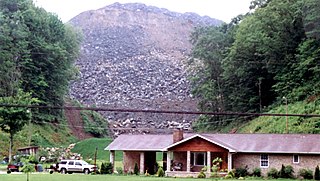
The Big Sandy River, called Sandy Creek as early as 1756, is a tributary of the Ohio River, approximately 29 miles (47 km) long, in western West Virginia and northeastern Kentucky in the United States. The river forms part of the boundary between the two states along its entire course. Via the Ohio River, it is part of the Mississippi River watershed.

In mining, tailings or tails are the materials left over after the process of separating the valuable fraction from the uneconomic fraction (gangue) of an ore. Tailings are different from overburden, which is the waste rock or other material that overlies an ore or mineral body and is displaced during mining without being processed.
The Buffalo Creek flood was a disaster that occurred in Logan County, West Virginia on February 26, 1972 when a coal slurry impoundment dam burst, causing significant loss of life and property damage.

Massey Energy Company was a coal extractor in the United States with substantial operations in West Virginia, Kentucky and Virginia. By revenue, it was the fourth largest producer of coal in the United States and the largest coal producer in Central Appalachia. By coal production weight, it was the sixth largest producer of coal in the United States.
Blackwater is a form of pollution produced in coal preparation. In its purification, coal is crushed in a coal preparation plant and then separated and transported as a coal slurry, From the slurry, incombustible materials are removed and the coal can be sized. After the recovery of the coal particles from this slurry, the remaining water is black, contains very fine particles of coal. This blackwater cannot be processed in a water treatment plant.

Sludge is a 2005 documentary film by Appalshop filmmaker Robert Salyer chronicling the Martin County Sludge Spill that was an accident that occurred after midnight on October 11, 2000, when a coal sludge impoundment in Martin County, Kentucky, broke through an underground mine below, propelling 306 million gallons of sludge down two tributaries of the Tug Fork River. The movie documents the continuing story of the Martin County disaster, the resulting federal investigation, and the looming threat of coal sludge ponds throughout the coalfield region.
Coal slurry is a mixture of solids and liquids produced by a coal preparation plant.

The Kingston Fossil Plant coal fly ash slurry spill was an environmental and industrial disaster that occurred on December 22, 2008, when a dike ruptured at a coal ash pond at the Tennessee Valley Authority's Kingston Fossil Plant in Roane County, Tennessee, releasing 1.1 billion US gallons of coal fly ash slurry. The coal-fired power plant, located across the Clinch River from the city of Kingston, used a series of ponds to store and dewater the fly ash, a byproduct of coal combustion. The spill released a slurry of fly ash and water which traveled across the Emory River and its Swan Pond embayment onto the opposite shore, covering up to 300 acres (1.2 km2) of the surrounding land. The spill damaged multiple homes and flowed into nearby waterways including the Emory River and Clinch River, both tributaries of the Tennessee River. It was the largest industrial spill in United States history.

The Upper Big Branch Mine disaster occurred on April 5, 2010 roughly 1,000 feet (300 m) underground in Raleigh County, West Virginia at Massey Energy's Upper Big Branch coal mine located in Montcoal. Twenty-nine out of thirty-one miners at the site were killed. The coal dust explosion occurred at 3:27 pm. The accident was the worst in the United States since 1970, when 38 miners were killed at Finley Coal Company's No. 15 and 16 mines in Hyden, Kentucky. A state funded independent investigation later found Massey Energy directly responsible for the blast.
Climate Ground Zero (CGZ), founded in February 2009, is a non-violent civil disobedience campaign against mountaintop removal mining based in the southern coalfields of West Virginia. According to their website, Climate Ground Zero believes “that the irrevocable destruction of the mountains of Appalachia and its accompanying toll on the air, water, and lives of Appalachians necessitates continued and direct action". The organization seeks to end mountaintop removal mining by drawing attention to the issue through protests involving trespass on the property of mining companies. By locking down to machinery on mine sites, occupying trees in the blast zone, or blockading haul roads to mine sites, protesters associated with Climate Ground Zero directly interfere with mining practices. Other protests draw attention to the alleged negligence of regulatory agencies such as the West Virginia Department of Environmental Protection (WVDEP) or the federal Environmental Protection Agency (EPA) by occupying the offices of these governmental organizations. Climate Ground Zero has been referenced in the New York Times, Los Angeles Times, Washington Post, Democracy Now, and the Associated Press.

Water pollution in the United States is a growing problem that became critical in the 19th century with the development of mechanized agriculture, mining, and industry, although laws and regulations introduced in the late 20th century have improved water quality in many water bodies. Extensive industrialization and rapid urban growth exacerbated water pollution as a lack of regulation allowed for discharges of sewage, toxic chemicals, nutrients and other pollutants into surface water.
This is a list of notable events relating to the environment in 2000. They relate to environmental law, conservation, environmentalism and environmental issues.
The Brushy Fork Coal Impoundment, also known as the Brushy Fork Coal Sludge Dam, is a large tailings dam on the Brushy Fork near Marfork in western Raleigh County of West Virginia, United States. It is located 18 mi (29 km) northwest of Beckley, the seat of Raleigh County. Brushy Fork flows into Little Marsh Fork, which then enters Marsh Fork, which is a tributary of the Coal River. The purpose of the dam is to store a sludge consisting of tailings and waste from a nearby coal mine. In 1995 Massey Energy received a permit to construct the dam. Over the years additional permits to increase the size and storage volume of the dam have been issued in the midst of local and regional opposition to its structural integrity. Currently at approximately 900 ft (270 m) in height, it is the tallest dam in the Western Hemisphere. When complete its designed height will be 954 ft (291 m). Wasted rock from the coal mining process is used as the dam filler. The dam currently withholds about 25,100 acre⋅ft (31,000,000 m3) of waste. This capacity will be increased to 30,075 acre⋅ft (37,097,000 m3) upon completion.
Mountain Justice is a grassroots movement established in 2005 to raise worldwide awareness of mountaintop removal mining and its effects on the environment and peoples of Appalachia. The group seeks to encourage conservation, efficiency, solar and wind energy as alternatives to all forms of surface mining. It self-describes as "a regional Appalachian network committed to ending mountaintop removal". It seeks justice because the mountaintop removal (MTR) it opposes is a form of coal mining known as mountaintop removal mining which produces coal sludge toxic waste which is stored in a dam on the mountain and leaches into the groundwater, which poisons the environment, which defaces the top of the mountain, and which is not stopped due to political corruption.

Environmental justice and coal mining in Appalachia is the study of environmental justice – the interdisciplinary body of social science literature studying theories of the environment and justice; environmental laws, policies, and their implementations and enforcement; development and sustainability; and political ecology – in relation to coal mining in Appalachia.

Environmental issues in Appalachia, a cultural region in the Eastern United States, include long term and ongoing environmental impact from human activity, and specific incidents of environmental harm such as environmental disasters related to mining. A mountainous area with significant coal deposits, many environmental issues in the region are related to coal and gas extraction. Some extraction practices, particularly surface mining, have met significant resistance locally and at times have received international attention.

In February 2014, an Eden, North Carolina facility owned by Duke Energy spilled 39,000 tons of coal ash into the Dan River. The company later pled guilty to criminal negligence in their handling of coal ash at Eden and elsewhere and paid fines of over $5 million. The U.S. Environmental Protection Agency (EPA) has since been responsible for overseeing cleanup of the waste. EPA and Duke Energy signed an administrative order for the site cleanup.
Jack Spadaro is an American mining engineer. He is from West Virginia and is known for bringing attention to oversights of the government in relation to the Martin County coal slurry spill and whistleblowing on the subsequent downplaying of the role of the government and Massey Energy in the disaster.
The Martin County water crisis is an on-going public health crisis that began in 2000, when a coal slurry spill contaminated the area’s water supply with cancer-causing disinfection byproducts and coliform bacteria. Residents report the water having a strong smell of chlorine, discoloration, odd taste, sediment and irritation/burning when in contact with skin. The contamination was caused by the spillage of approximately 300 million gallons of arsenic and mercury concentrated coal sludge into an abandoned underground mine and two tributaries of the Tug Fork River by local coal company Massey Energy Company on October 11, 2000. According to the Environmental Protection Agency (EPA), the spill was one of the worst environmental disasters ever in the southern United States.











